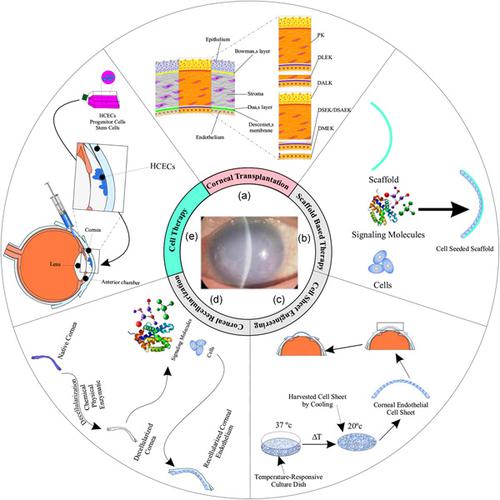当前位置:
X-MOL 学术
›
J. Cell. Physiol.
›
论文详情
Our official English website, www.x-mol.net, welcomes your
feedback! (Note: you will need to create a separate account there.)
Corneal endothelium tissue engineering: An evolution of signaling molecules, cells, and scaffolds toward 3D bioprinting and cell sheets
Journal of Cellular Physiology ( IF 4.5 ) Pub Date : 2020-10-08 , DOI: 10.1002/jcp.30085 Mostafa Khalili 1, 2, 3 , Maryam Asadi 2 , Houman Kahroba 4 , Mohammad Reza Soleyman 5 , Helder Andre 6 , Effat Alizadeh 1
Journal of Cellular Physiology ( IF 4.5 ) Pub Date : 2020-10-08 , DOI: 10.1002/jcp.30085 Mostafa Khalili 1, 2, 3 , Maryam Asadi 2 , Houman Kahroba 4 , Mohammad Reza Soleyman 5 , Helder Andre 6 , Effat Alizadeh 1
Affiliation

|
Cornea is an avascular and transparent tissue that focuses light on retina. Cornea is supported by the corneal‐endothelial layer through regulation of hydration homeostasis. Restoring vision in patients afflicted with corneal endothelium dysfunction‐mediated blindness most often requires corneal transplantation (CT), which faces considerable constrictions due to donor limitations. An emerging alternative to CT is corneal endothelium tissue engineering (CETE), which involves utilizing scaffold‐based methods and scaffold‐free strategies. The innovative scaffold‐free method is cell sheet engineering, which typically generates cell layers surrounded by an intact extracellular matrix, exhibiting tunable release from the stimuli‐responsive surface. In some studies, scaffold‐based or scaffold‐free technologies have been reported to achieve promising outcomes. However, yet some issues exist in translating CETE from bench to clinical practice. In this review, we compare different corneal endothelium regeneration methods and elaborate on the application of multiple cell types (stem cells, corneal endothelial cells, and endothelial precursors), signaling molecules (growth factors, cytokines, chemical compounds, and small RNAs), and natural and synthetic scaffolds for CETE. Furthermore, we discuss the importance of three‐dimensional bioprinting strategies and simulation of Descemet's membrane by biomimetic topography. Finally, we dissected the recent advances, applications, and prospects of cell sheet engineering for CETE.
中文翻译:

角膜内皮组织工程:信号分子、细胞和支架向 3D 生物打印和细胞片的演变
角膜是一种无血管的透明组织,可将光线聚焦在视网膜上。角膜由角膜内皮层通过调节水合稳态来支持。患有角膜内皮功能障碍介导的失明的患者恢复视力通常需要角膜移植(CT),但由于供体的限制,角膜移植面临着相当大的限制。 CT 的一种新兴替代方案是角膜内皮组织工程 (CETE),其中涉及利用基于支架的方法和无支架策略。创新的无支架方法是细胞片工程,它通常生成被完整的细胞外基质包围的细胞层,表现出从刺激响应表面的可调释放。在一些研究中,据报道基于支架或无支架的技术取得了有希望的结果。然而,将 CETE 从实验室转化为临床实践仍存在一些问题。在这篇综述中,我们比较了不同的角膜内皮再生方法,并详细阐述了多种细胞类型(干细胞、角膜内皮细胞和内皮前体)、信号分子(生长因子、细胞因子、化学化合物和小RNA)和CETE 的天然和合成支架。此外,我们讨论了三维生物打印策略和通过仿生地形模拟后弹力层的重要性。最后,我们剖析了CETE细胞片工程的最新进展、应用和前景。
更新日期:2020-10-08
中文翻译:

角膜内皮组织工程:信号分子、细胞和支架向 3D 生物打印和细胞片的演变
角膜是一种无血管的透明组织,可将光线聚焦在视网膜上。角膜由角膜内皮层通过调节水合稳态来支持。患有角膜内皮功能障碍介导的失明的患者恢复视力通常需要角膜移植(CT),但由于供体的限制,角膜移植面临着相当大的限制。 CT 的一种新兴替代方案是角膜内皮组织工程 (CETE),其中涉及利用基于支架的方法和无支架策略。创新的无支架方法是细胞片工程,它通常生成被完整的细胞外基质包围的细胞层,表现出从刺激响应表面的可调释放。在一些研究中,据报道基于支架或无支架的技术取得了有希望的结果。然而,将 CETE 从实验室转化为临床实践仍存在一些问题。在这篇综述中,我们比较了不同的角膜内皮再生方法,并详细阐述了多种细胞类型(干细胞、角膜内皮细胞和内皮前体)、信号分子(生长因子、细胞因子、化学化合物和小RNA)和CETE 的天然和合成支架。此外,我们讨论了三维生物打印策略和通过仿生地形模拟后弹力层的重要性。最后,我们剖析了CETE细胞片工程的最新进展、应用和前景。











































 京公网安备 11010802027423号
京公网安备 11010802027423号